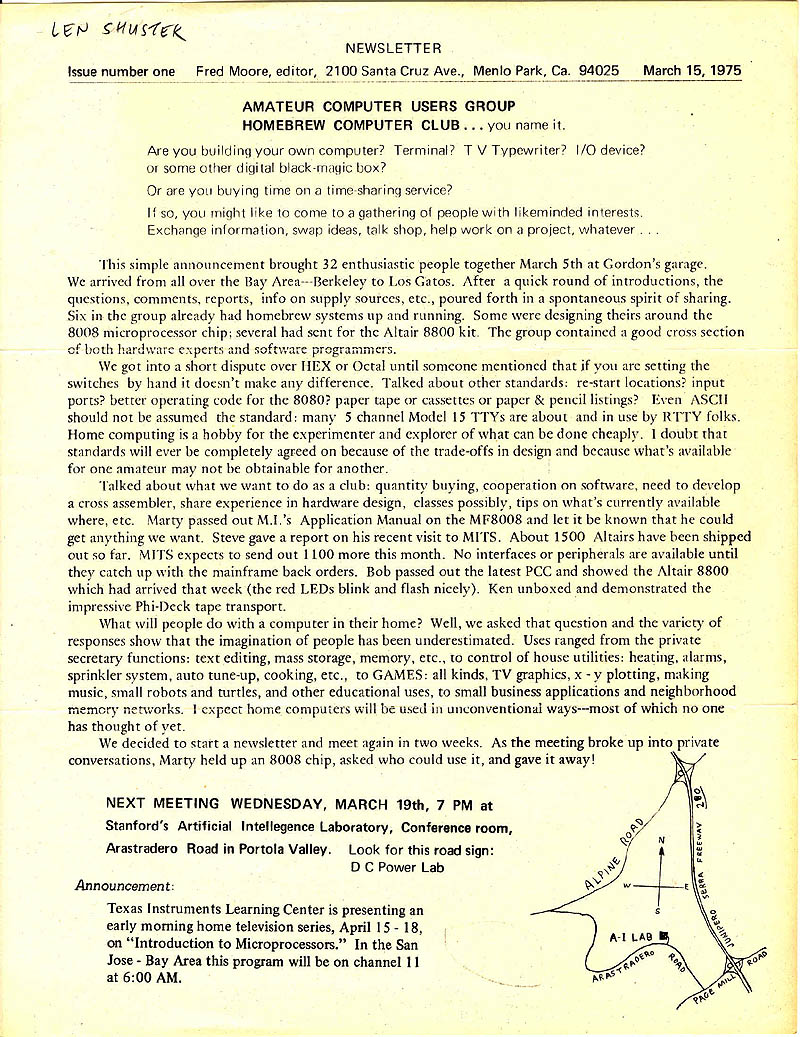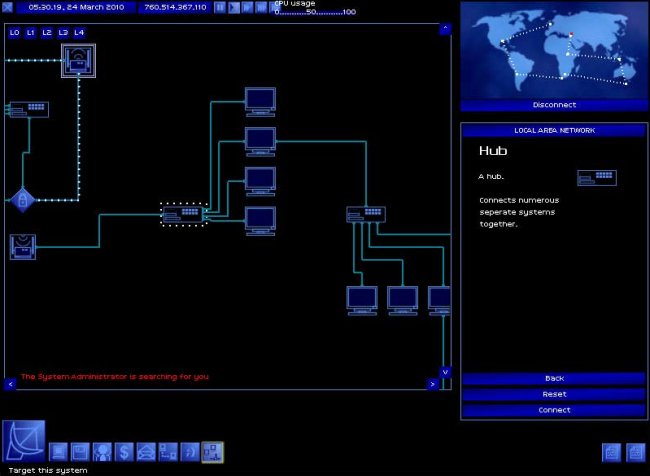Today in Cyberpunk History (March 5, 1975): A group of tech-minded guys meet at a garage in Menlo Park, San Mateo County, California, USA for the first time. They gathered to discuss the first Micro Instrumentation and Telemetry Systems Altair microcomputer. MITS was founded in 1969 by Ed Roberts and Forrest Mims to make electronic telemetry for model rockets before switching to electronic calculators in 1971. When a pricing war left MITS near bankruptcy in 1974, Roberts developed the Altair 8800. When 1975 came around, the Altair 8800 became the popular computer, and many organizations began forming to debate, discuss, share, and trade ideas, schematics, and even programs for it.
In Menlo Park, Gordon French and Fred Moore wanted to get other techies from the area to join in a regular open forum to make computers like the Altair more accessible to everyone. The first meeting was held in French’s garage before moving to the Stanford Linear Accelerator Center for regular meetings, then to an El Camino Real bar and grill to “reconvene.”
The Power of The Press.

10 days after its founding the HbCC gave its “Hello, World!” with this newsletter. Thanks to its members the newsletter became THEE document to influence Silicon Valley. To view the entire series @ DigiBarn.com, just click the image above
The Homebrew Computer Club was now set to be the main driving force behind computing for the rest of the 70’s and into the 80’s… and beyond. Even so, there were some notable detractors. Example: Microsoft founder Bill Gates who wrote an “Open Letter to Hobbyists” that described them in not-so-gentle terms:
(from the online version) As the majority of hobbyists must be aware, most of you steal your software. Hardware must be paid for, but software is something to share. Who cares if the people who worked on it get paid?
Is this fair? One thing you don’t do by stealing software is get back at MITS for some problem you may have had. MITS doesn’t make money selling software. The royalty paid to us, the manual, the tape and the overhead make it a break-even operation. One thing you do do is prevent good software from being written. Who can afford to do professional work for nothing? What hobbyist can put 3-man years into programming, finding all bugs, documenting his product and distribute for free? The fact is, no one besides us has invested a lot of money in hobby software. We have written 6800 BASIC, and are writing 8080 APL and 6800 APL, but there is very little incentive to make this software available to hobbyists. Most directly, the thing you do is theft.
Sound familiar? Probably because it’s the same reason the MPAA/RIAA/BSA use today to discourage such file sharing. Unlike today, the response didn’t involve hacking law enforcement systems or hitting them with distributed denial of service attacks. Instead, Apple computers used a different philosophy by bundling software with the hardware and promising “to provide software for our machines free or at minimal cost” (check this Oct-1976 advert for the Apple I). Maybe the best reaction came from Homebrew member Jim Warren:
There is a viable alternative to the problems raised by Bill Gates in his irate letter to computer hobbyists concerning “ripping off” software. When software is free, or so inexpensive that it’s easier to pay for it than to duplicate it, then it won’t be “stolen”.
Member’s List. Just who was involved with Homebrew? This may not be a complete list, but it should give you an idea of the people involved:
Fred Moore: Founder and political activist
George Morrow: Improved the Altair’s S-100 system bus
Adam Osbourne: Osbourne Computer Corporation
Lee Felsenstein: Designer of the Osboune 1 computer
John Draper: aka “Captain Crunch” (phone phreak)
Jerry Lawson: Designed the Fairchild Chanel F console (first ROM cartridge system)
Jim Warren: Dr. Dobb’s Journal, then on the Board of Directors of Autodesk, Inc.
Two guys named Steve (Jobs & Steve Wozniak): Founded some company that made computers, phones, music players…
You get the idea of the club’s brainpower.
…And the rest is history. From that first meeting in the garage to today’s clubs around the world, Homebrew still continues to meet to exchange codes, schematics, and ideas of bringing computers to the masses, though today’s homebrew clubs have turned their attention to game consoles like the X-Box and Wii. The spirit is still there, still influencing the tech minded, still revolutionizing the computer world.
This post has been filed under Cyberpunk History by Mr. Roboto.
Today in Cyberpunk History (March 1, 1990): Early morning at Steve Jackson Games in Austin, Texas saw an invasion of US Secret Service agents seizing any system used for GURPS Cyberpunk RPG book. They were looking for “evidence” to convict one of SJ Games’s employees: One Loyd Blankenship, whose home was also raided. It wouldn’t be until October when SJ Games learned why they were raided as the warrant was sealed (You can view the warrant here).
Guilt by Association. The primary target of the raid was Loyd Blankenship, who was known in hacker circles as +++The Mentor+++, member of Legion of Doom. He also ran a BBS that distributed the hacker journal Phrack, that published the contents of a text file from Bell South that dealt with the 911 emergency response system in 1989. The file contained no schematics, no codes, no technical anything… it was only an administrative book that Bell South would sell to the public for $13 US. Yet it was feared that the file would be used by hackers to disrupt the 911 system, and Bell South claimed the posting caused 80 thousand dollars in damage.

GURPS Cyberpunk was an unfortunate victim of circumstance. The agents saw it and thought it was a real book about hacking. And with the rest of Operation Sundevil going on nationwide, why not make Steve Jackson Games an example?
The System Eats Itself. On the afternoon of January 15, 1990, AT&T’s long distance network began a downward spiral that lead to a near shutdown. The cause was a simple programming error what would cause a software crash when it got messages from switching stations coming back online. The crash required an automatic reboot of the switching station, which lead to the transmission of “back online” messages to its neighbors. But those messages would knock those switches offline, and generate more messages that would knock more switches offline…
An investigation did show that it was a programming error that caused the crash. The problem was nobody wanted to believe it. For a company and computers to make such a FUBAR is unheard of, and everyone from the government to the media to the clueless sheeple on the street wanted to believe it was deliberate act by someone. Who could possibly have the ability to cause such calamity?
Hackers. They’ve shown they could get into most any system and do… things. Why not crash a major infrastructure? In May 1990 Garry M. Jenkins, Assistant Director of the US Secret Service, made the following comment in a press release:

“The Secret Service is sending a clear message to those computer hackers who have decided to violate the laws of this nation in the mistaken belief that they can successfully avoid detection by hiding behind the relative anonymity of their computer terminals.”
Thus began the shitstorm that was Sundevil.
Revenge of The Geeks. Mid-1990 saw the founding of the Electronic Frontier Foundation (EFF), the organization that fights for freedom of the Internet. Operation Sundevil itself was seen as just a publicity stunt since, as a “law-enforcement tool,” it failed to produce any convictions. The saga can be read about via Bruce Sterling’s book The Hacker Crackdown.
As for SJ Games, they finally had their day in court in 1993. They were acquitted on two of the three counts against them. Their story can be read, along with the relevant documents, on their website.
This post has been filed under Cyberpunk History by Mr. Roboto.
Source: Wired, and elsewhere.

Those of you who never experienced the days of the “command line” or “DOS prompt” may not realize the impact that the bulletin board system, or BBS, has on today’s Internet. The archive site textfiles.com seeks to preserve those heady, monochrome, dial-up days for old-timers to relive and for the curious to see what the net was like before GUIs. Click the image to get there.
Future calling. When Ward Christensen and Randy Suess first put their computerized bulletin board system, or CBBS, online for the first time they probably never realized how it would become a major part of the net as we know it today. The idea came to them as a result of being snowbound, they wanted to take the cork-and-tack based bulletin boards and make it electronic so others can post… well, just about anything:
(Wired) It was several decades before the hardware or the network caught up to Christensen and Suess’ imaginations, but all the basic seeds of today’s online communities were in place when the two launched the first bulletin board, dubbed CBBS for computerized bulletin board system. The two developers announced their creation to the world in the November 1978 issue of Byte magazine.
The article created a stir among hobbyists and hackers, and it wasn’t long before others begin building clones of CBBS. By the mid-1980s, BBSs supported an active community with no less than three magazines devoted to covering the latest in the proto-online world.
Primitive, but consider some of the tools today’s netizen has for similar communications: Forums (like our Virtual Meatspace), blogs (akin to posting a newsletter on those cork boards), and instant messaging, including Twitter.
The world was yours for a (modem) song. Since there was no broadband services back then, you had to program your modem (”baud,” anyone?) to dial a number to access a BBS. And when you finally were connected, you found mostly technical stuff posted there since many of the early adopters were the hacker types. But, you may have also found some ways to make free phone calls thanks to some friendly “phreakers” (phone system hackers) so you were able to call those out-of-area BBSs to find the latest news, warez, or porn (done in tasteful ASCII).
More info to download… Wired’s news piece is only a small sample of what BBSs has become. To see what the past was like, click over to textfiles.com and peruse the files they have there (Try searching for “cyberpunk” on their site!). Also, there’s an in-depth look at the history of BBSs in a 3 DVD set called BBS: The Documentary. I’m going to try ordering it and see about a review for you.
This post has been filed under Cyberpunk History by Mr. Roboto.
Sources: Wired, Stanford University MouseSite

From this simple-looking wood block with a button and a cable began a 40 year trek that culminated in the modern computer as we know it. Yes!
The (computer) mouse that roared. When Doctor Doug Engelbart first demonstrated his computer in 1968, he probably didn’t realize what impact his system would have on the world. After all, computers were not exactly “personal” back then. But Dr. Engelbart’s system, which he and 17 researchers had been working on since 1962, would indeed impact our world like a Jupiter-sized meteor. An impact that we still feel today. What exactly was his incredible system was about?
From Wired:
The presentation included the debut of the computer mouse, which Engelbart used to control an onscreen pointer in exactly the same way we do today. For a world used to thinking of computers as impersonal boxes that read punched cards, whir awhile, then spit out reams of teletype paper, this kind of real-time graphical control was amazing enough.
But Engelbart went beyond merely demonstrating a new input device — way beyond. His demo that day in San Francisco’s Brooks Hall also premiered “what you see is what you get” editing, text and graphics displayed on a single screen, shared-screen videoconferencing, outlining, windows, version control, context-sensitive help and hyperlinks. Bam!
Does all this sound familiar yet? One more thing: Dr. Engelbart used his super-system to demonstrate a new “network,” the NLS or “oNLine System” which was being used at Stanford. Videos of the “The Mother of All Demos” can be found on Stanford University MouseSite.

The Internet, Windows, OS X,… Today (December 9, 1968) is the 40th anniversary of the demo that influenced the world… and in a way, cyberpunk as well.
This post has been filed under Cyberpunk History by Mr. Roboto.
|









